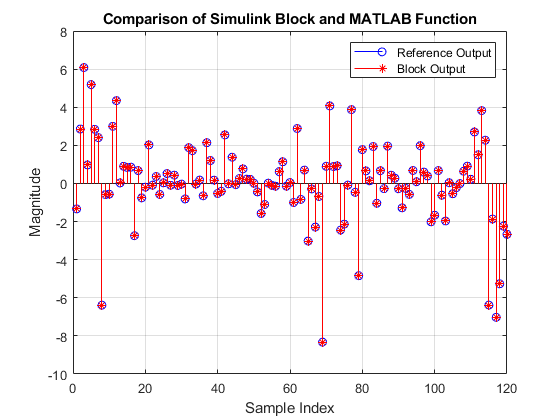DVB-S2 Symbol Demodulator
Demodulate complex constellation symbol to set of LLR values or data bits according to DVB-S2 standard
Since R2021b
Libraries:
Wireless HDL Toolbox /
Modulation
Description
The DVB-S2 Symbol Demodulator block demodulates complex data symbol to
log-likelihood ratio (LLR) values or data bits based on the modulation types supported by the
Digital Video Broadcast Satellite Second Generation (DVB-S2) standard [1]. The block accepts equalized
complex data symbols and a samplecontrol bus or a valid
signal. It outputs demodulated LLR values or data bits and a samplecontrol
bus or a valid signal based on the selected output type. The block provides
an option to select the output type as vector or scalar. The number of demodulated LLR values
or data bits for a given symbol depends on the modulation type, as this table shows.
| Modulation Type | Number of LLR Values or Data Bits Per Symbol |
|---|---|
| π/2-BPSK | 1 |
| QPSK | 2 |
| 8-PSK | 3 |
| 16-APSK | 4 |
| 32-APSK | 5 |
The block provides an architecture suitable for HDL code generation and hardware deployment. You can use this block in the development of a DVB-S2 receiver.
Examples
Ports
Input
Output
Parameters
Algorithms
References
[1] ETSI Standard EN 302 307 V1.4.1: Digital Video Broadcasting (DVB); Second generation framing structure, channel coding and modulation systems for Broadcasting, Interactive Services, News Gathering and other broadband satellite applications (DVB-S2), European Telecommunications Standards Institute, Valbonne, France, 2005-03.
[2] Viterbi, A.J. “An Intuitive Justification and a Simplified Implementation of the MAP Decoder for Convolutional Codes.” IEEE Journal on Selected Areas in Communications 16, no. 2 (February 1998): 260–64. https://doi.org/10.1109/49.661114.
[3] Sebesta, J. “Efficient Method for APSK Demodulation.” Selected Topics on Applied Mathematics, Circuits, Systems, and Signals (P. Pardalos, N. Mastorakis, V. Mladenov, and Z. Bojkovic, eds.). Vouliagmeni, Athens, Greece: WSEAS Press, 2009.
Extended Capabilities
Version History
Introduced in R2021bSee Also
Functions
dvbsapskdemod(Satellite Communications Toolbox)
Blocks
- DVB-S2 Symbol Modulator | DVBS-APSK Demodulator Baseband (Satellite Communications Toolbox)


